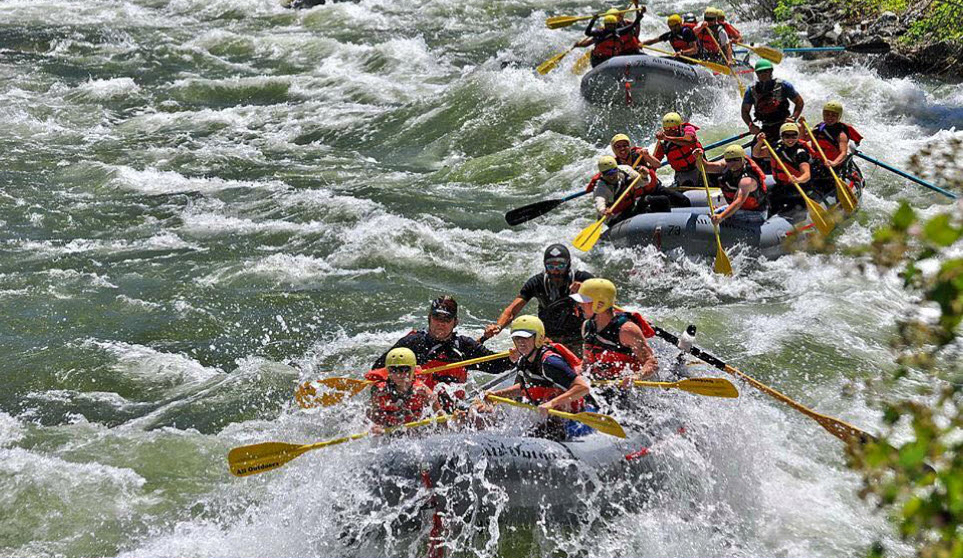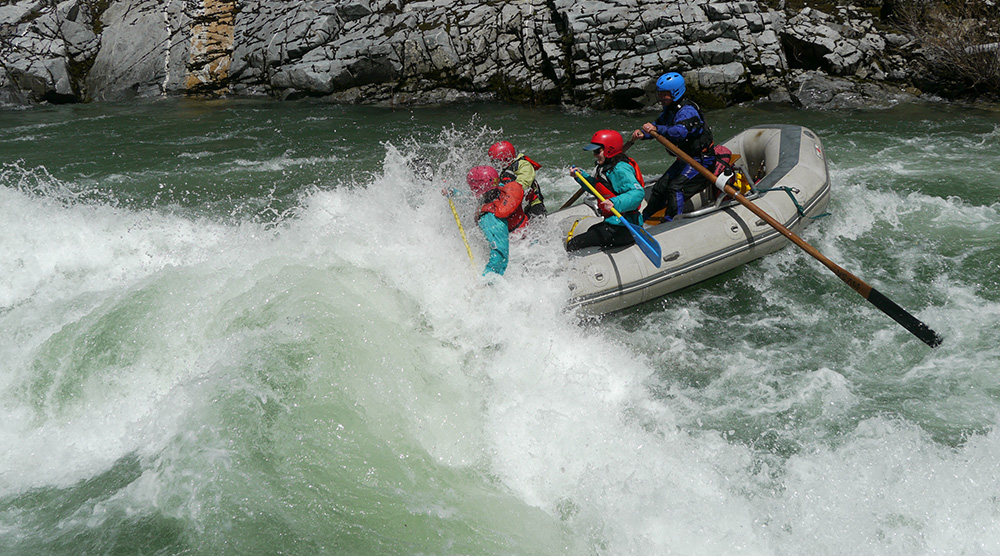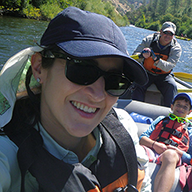Spring Season Rafting at Higher River Flows
Posted April 26, 2023 by Lenka Bostian
Spring rafting in California is excellent regardless of the snowpack levels. There are more rivers to choose from, fewer rafters and more wildlife to encounter on the water. The river canyons are alive with bright spring colors and the melting snow adds more water to the river. (Read more about Planning a California Spring River Rafting Trip.)
In some years the winter snowpack swells to well above the historical averages resulting in unusually high runoff come spring snowmelt. It is in such big snowpack years that additional considerations need to be taken into account when planning a rafting trip during the spring “higher flows” period.
What higher flows mean for your rafting trip
Higher flows affect different rivers in different ways. However, what all rivers at higher flows have in common are the unique and exciting ways the river changes. In general, the river flows much faster with waves and hydraulics becoming larger and more powerful. Sometimes, the well-known rapids on the river become tamer or “washed out” (more water fills in the rapid, creating a mellower ride), while normally calm parts of the river erupt in challenging rapids. One thing is always a constant – your ride will be boisterous, dynamic, and swift. You’ll find your way through one rapid and be at the entrance of another. At times, the entire river may feel like one long rapid. It’s a vigorous, spirited ride.
The timing and duration of the higher flow period depend on the amount of snow and the weather conditions throughout the spring. Warm weather accelerates the snowmelt and thus increases the river flows (sometimes very quickly). A more gradual melt caused by moderate temperatures evens out and extends the higher flow season. Depending on the river, higher flows in a big snowpack year typically last into late June and sometimes even into early to mid-July.

How All-Outdoors prepares for trips at higher flows
In our 60+ years on California rivers, we’ve experienced our share of big water rafting and have learned a lot. We prepare for higher flows in many ways. First and foremost, we are monitoring the river flows constantly. In terms of the actual operation of our trips, here are a few of the measures we implement:
- When appropriate, we switch from paddle rafts to oar-paddle combination rafts for more power and maneuverability.
- We organize specialized high-water training trips for our guides.
- We increase our guide-to-guest ratio on trips.
Finally, we want to make sure that every guest that joins us on the river has a great experience, regardless of the river conditions. Before you make your reservation with us for a springtime trip in an above-average snowpack year, we encourage you to talk to one of our California Rafting Consultants to help you choose a river trip appropriate for your group. In the meantime, please review the following information with everyone in your group.
Checklist for spring rafting in a big snowpack year
No paddling experience is required
Is this going to be your first time on a whitewater rafting trip? Taken alone, that’s not a problem. Plenty of people go rafting during higher flow rafting trips without having ever been before and have a great time. If this is your first trip, we typically recommend starting on the South Fork of the American River. On our more advanced rivers, previous paddling experience is recommended but not required.
You should be a competent swimmer
In the event that you fall out of the boat, it helps to feel confident in your ability to stay relatively calm and swim actively under your guide’s direction. You don’t have to be an advanced swimmer, but you should be comfortable in the water and be able to swim hand over hand (freestyle strokes) when the situation calls for it. If you are not confident in your swimming ability, you should go rafting in the summer or fall when the rivers are typically running at normal flows.
Bring an adventurous attitude
It’s okay to be nervous, but paddlers should be up for a real adventure, including the possibility that you could unexpectedly fall out of the raft in a rapid. These experiences are often the highlights of the entire trip for many people; you may find yourself telling stories of how your entire crew fell into the river, and how you helped each other get back into your boat! Come to the river with the right mindset. A positive and flexible attitude and an ability to play well with others can go a long way toward making sure everyone in your boat has a great experience. Spring rafting means lots of variables – the weather, the river flows, the routes in rapids – so be ready for anything!
Recommended minimum ages may be increased
Rafting trips can be a great experience for the whole family, but spring season conditions may require us to increase our usual minimum age recommendations for each river. These guidelines are meant to help you decide whether a specific trip is appropriate for your child’s level of physical and mental maturity. During the summer and fall, normal summer flows and warmer weather provide plenty of river trip options for everyone ages 5 and up.
Dress for success: Wetsuits are required
Compared to normal summer flows, the water is colder and the weather may vary. Proper attire can make an otherwise cool day more comfortable so you can focus on the fun. You may either bring your own or, for your convenience, use a wetsuit and/or a splash jacket that we provide at the river. Also, review these additional layering tips to make sure you stay warm on your trip.
Good physical health is key
You don’t have to be an athlete, but rafting is a physically active team sport and everyone in your group should arrive prepared for a good workout, as well as the possibility that you might find yourself unexpectedly swimming in fast-moving water. To assess your physical condition before you book your trip, here are a few things you should be aware of:
- Body size and type
We want to provide everyone with the opportunity to go rafting with us. However, trips during higher springtime flows may not be suitable for everyone. We recognize that everyone carries their weight differently, but when it comes to whitewater rafting, size does matter. At a minimum, everyone must be able to fit into an All-Outdoors issued Personal Flotation Device (PFD). The maximum chest size our PFD can accommodate is 52 inches, measured under your arms around the fullest part of your chest and/or midsection.
Furthermore, if anyone in your boat falls out of the raft and into a rapid, your crew must be able to help pull them back in. The heavier the person, the more difficult this can be. In our experience, a person’s height-to-weight ratio can become a factor for people who are over 200 lbs (especially if they are well over 200 lbs.) Please be sure to discuss with us the height and weight of everyone in your group if you have any concerns or questions. - Physical limitations
Do you have any injuries, medical conditions or other physical limitations that may impede your ability to paddle, stay seated in the raft or hold your breath underwater without putting yourself at unnecessary additional risk?
Note: if anyone in your group has a physical consideration that requires assistance or the use of a prosthetic or other physical aid, special accommodations can be made in many cases with advanced notice before you make your reservation. - Heart and lung health
In particular, people who have a history of heart conditions or respiratory issues should confer with their medical doctor before joining any of our trips. Unexpected events (flips, swims, “dump trucks”, etc.) can and do happen occasionally – it’s part of the sport. Physical exertion or stress during these events can exacerbate some medical conditions.
Please talk to your physician and avoid putting yourself at unnecessary risk if you believe you have reason to be concerned.

Avoid that awkward moment when you get to the river
Please make sure everyone in your group is aware of these considerations both before you book your trip and before they make the drive on the day of the trip. In rare cases, a guest not meeting these requirements shows up for a trip and we have to tell them it is not in their best interest to go rafting that day. When this situation occurs, that person is not able to participate with the rest of the group. We do everything we can to educate everyone about the above requirements in order to avoid situations like this, but it does happen from time to time and it’s never fun for anyone.
Talk to us before you book
Spring rafting at higher flows can be exhilarating, but it is not for everyone. Each person in your group should be familiar with these considerations, as well as the specifics of the river trip you choose. If you have any questions or need further clarification about any of our trips, we’re more than happy to talk to anyone to help them make an assessment for themselves.
Let us know how we can help! We are available by phone, email and Live Chat.
